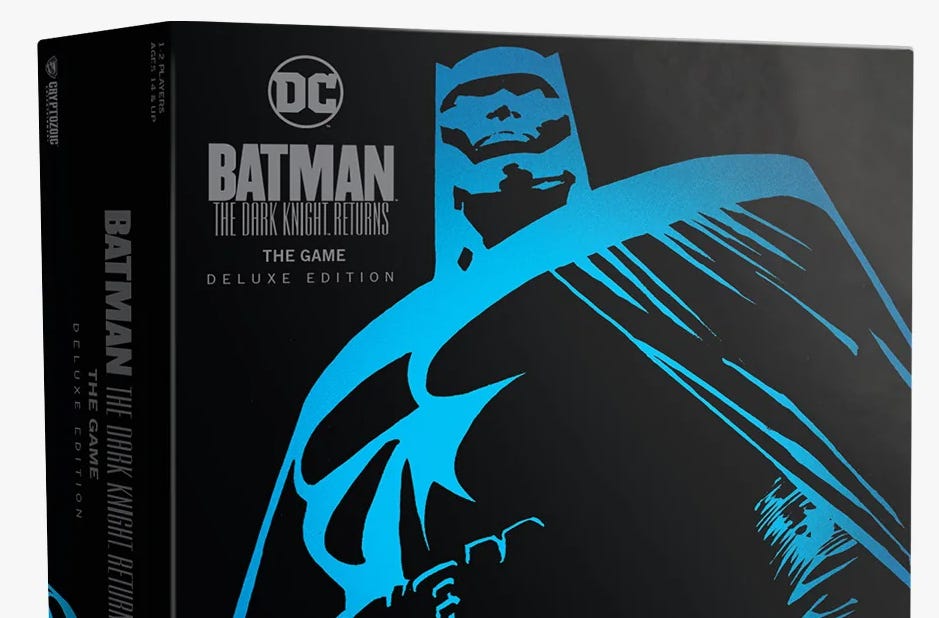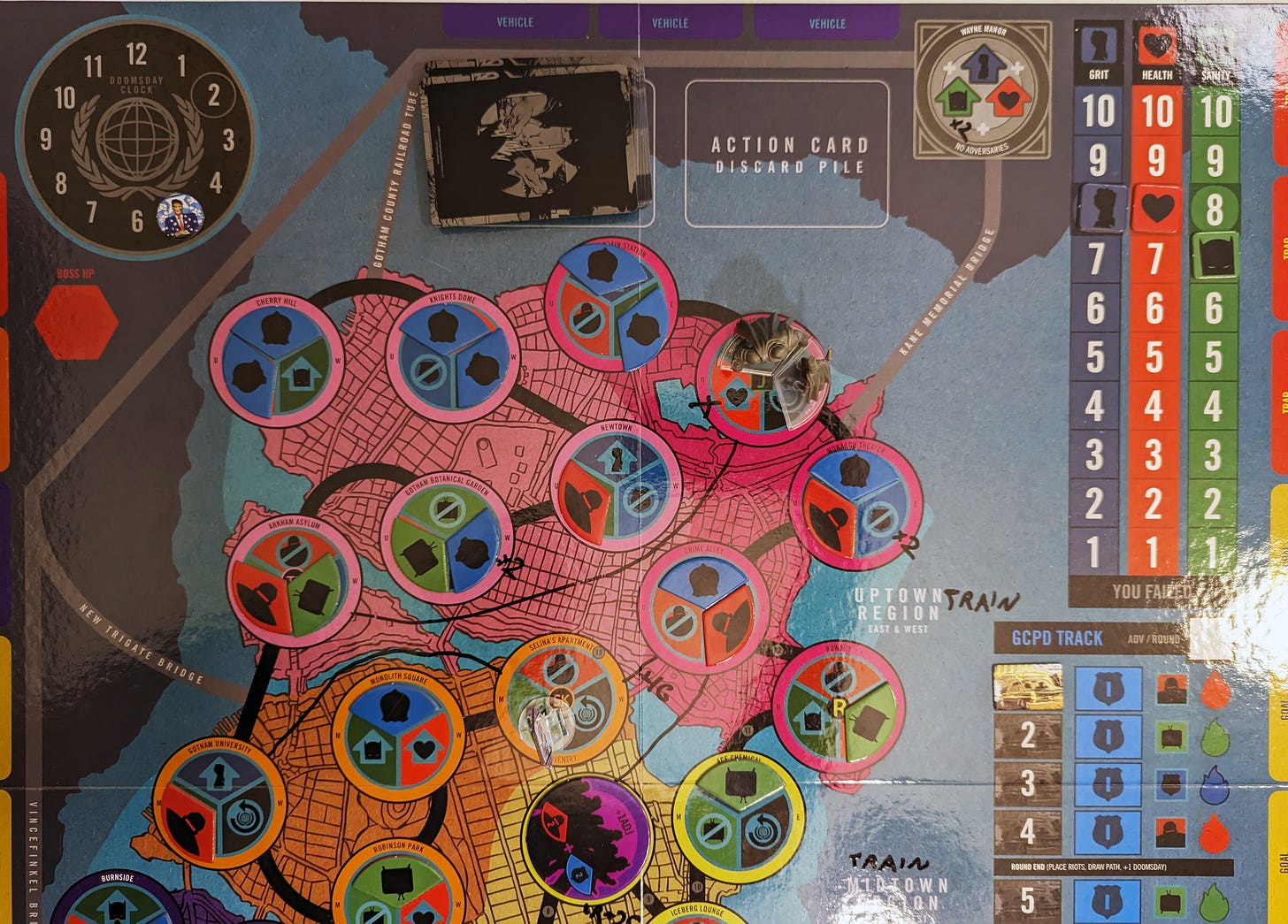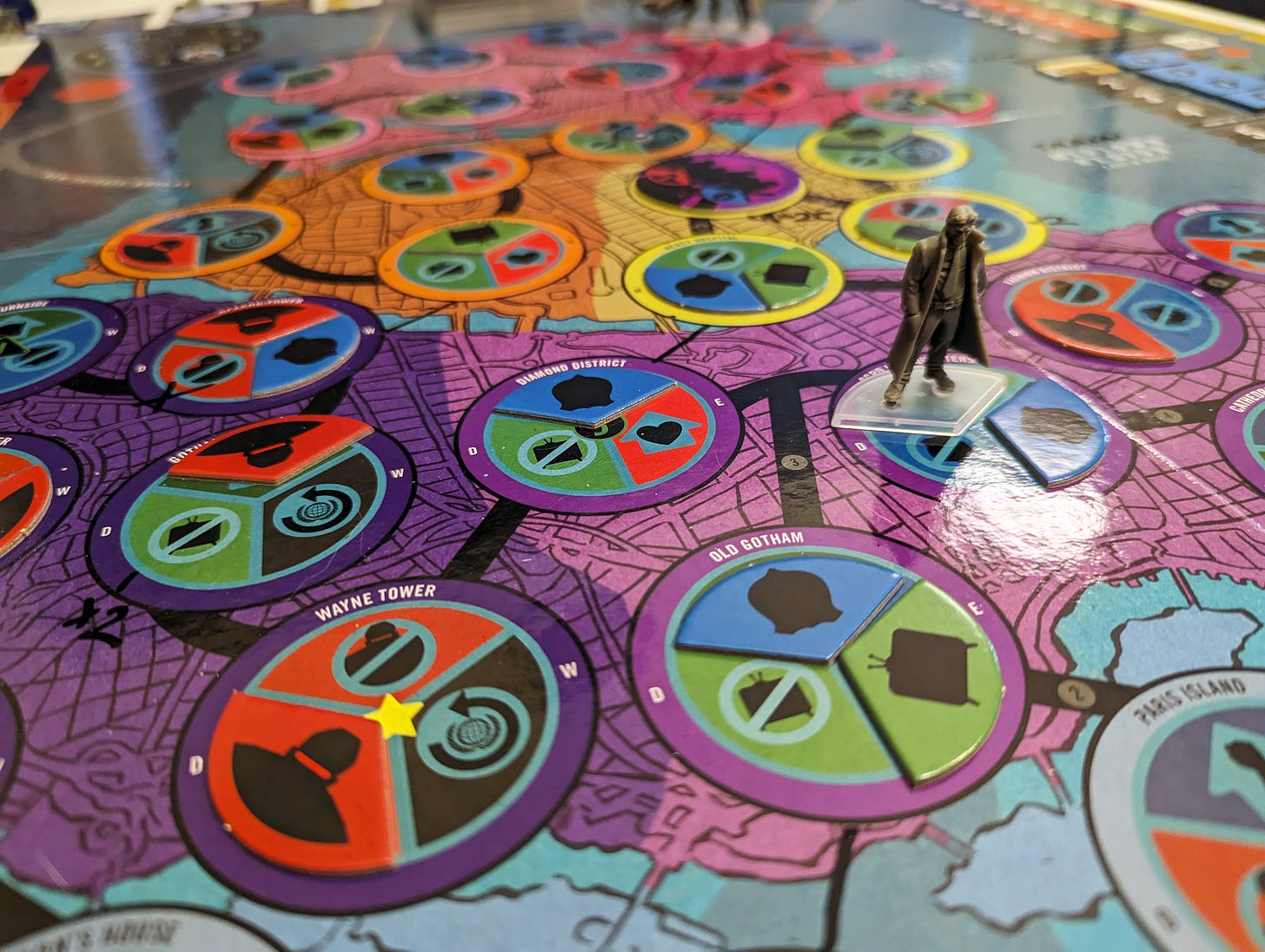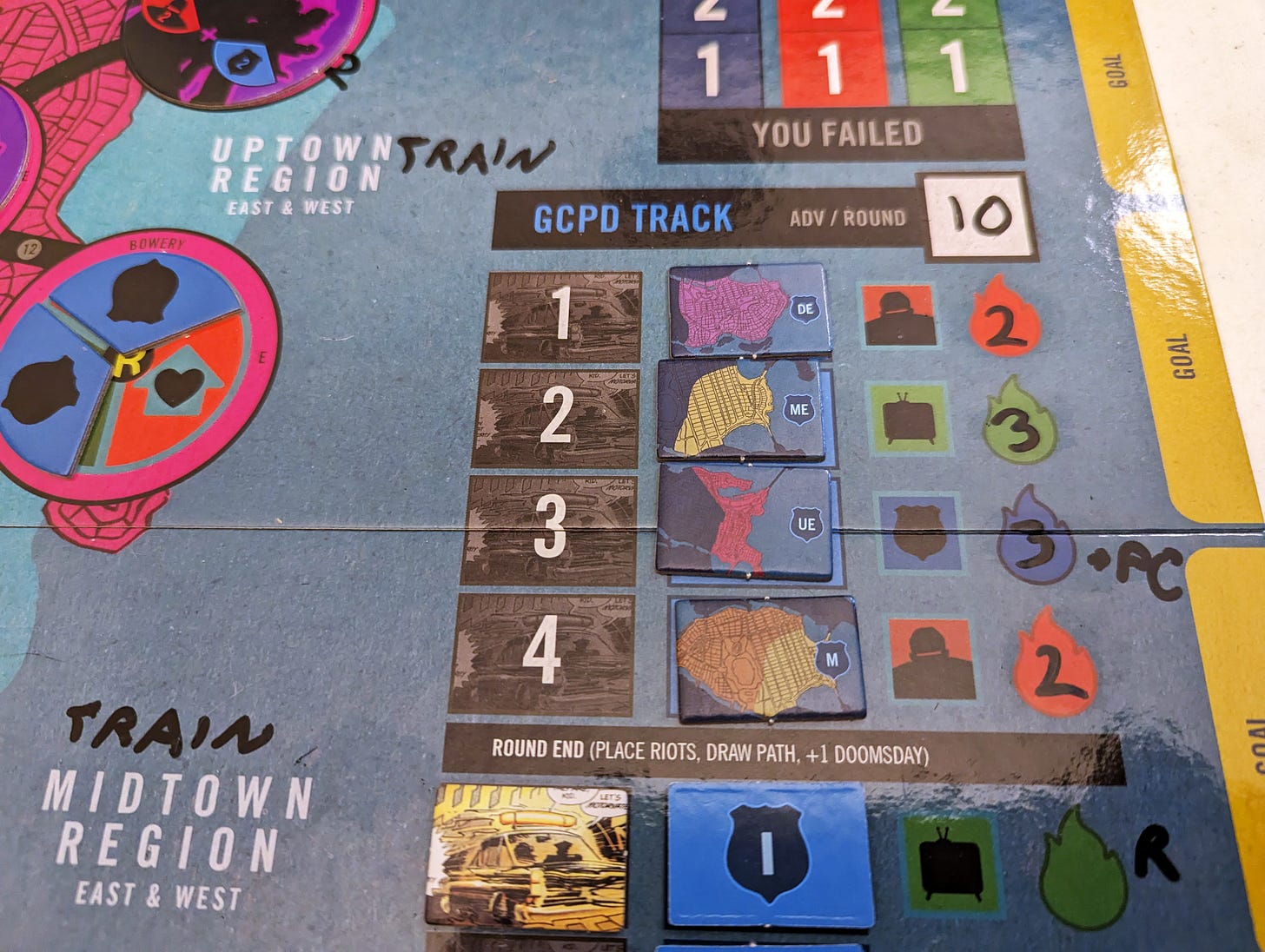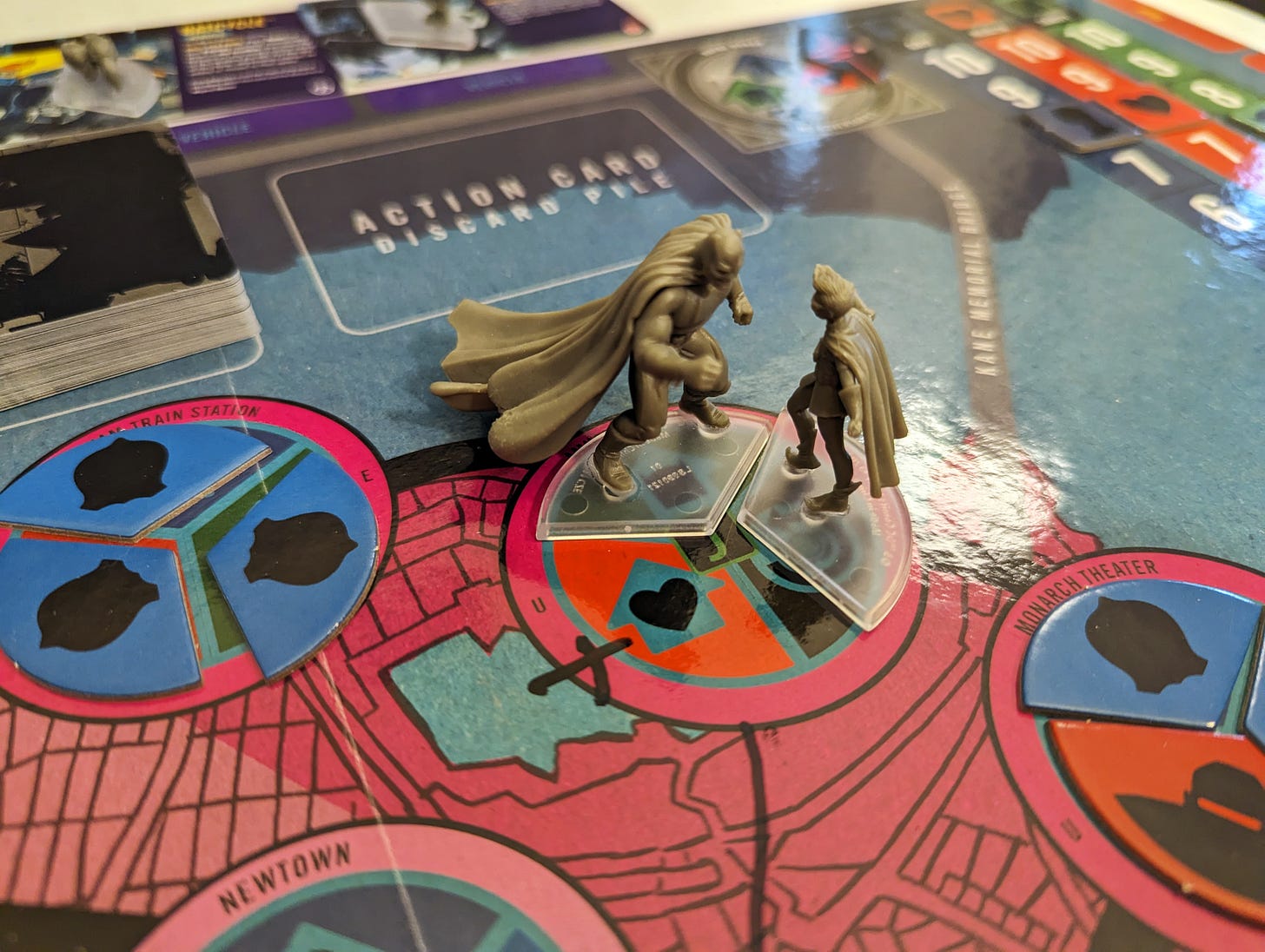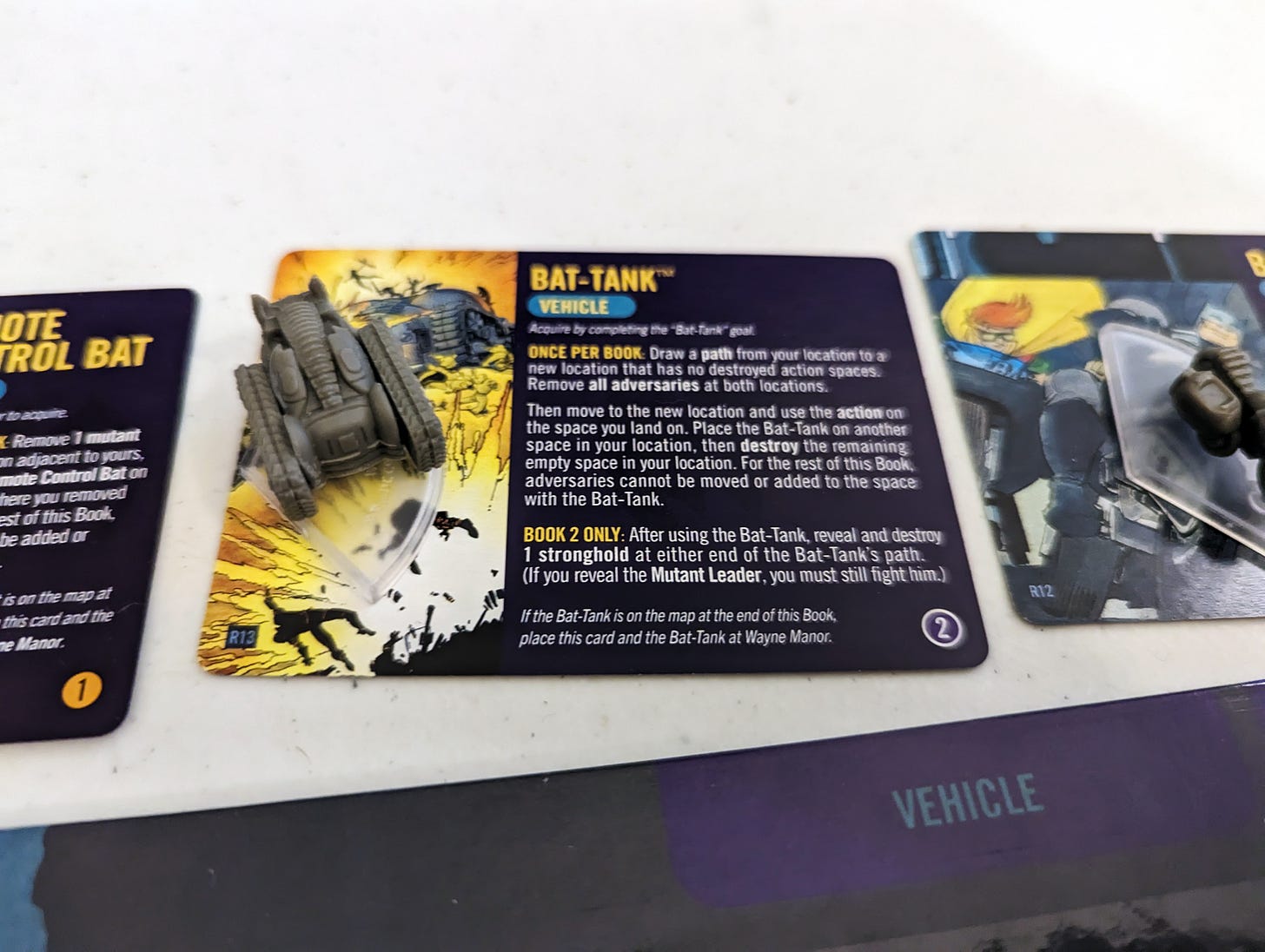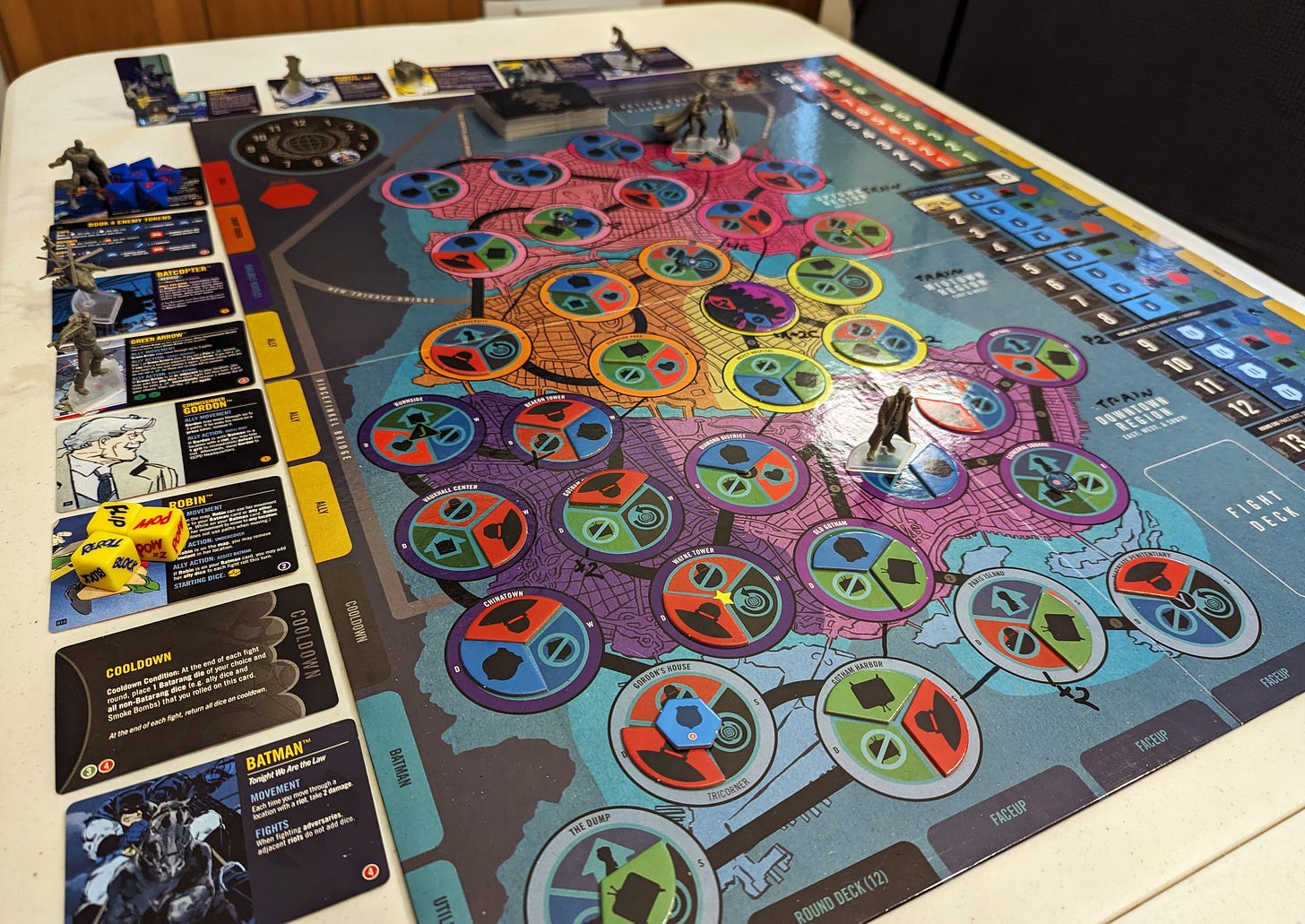A Tale of Two Batman Board Games: Part 2 - The Dark Knight Returns
It was the best of crimes...?
You’re reading Part 2 of my two part series about two Batman board games that I happened to play recently. Last time, I wrote about Batman: Everybody Lies, and now I’m moving on to the snappily titled Batman: The Dark Knight Returns - The Game (Deluxe Edition).
This one comes from Cryptozoic and is based on Frank Miller’s iconic 1986 comic of the same name (except without the “the game” part). I hadn’t read the comic in years, so to refresh my memory, I watched the 2013 animated adaptation before diving in. Unfortunately, I discovered that I wasn’t as much of a fan as I previously remembered. Regardless, I think The Dark Knight Returns: The Game is a mostly shining example of how to adapt a story for the board game medium.
The Dark Knight Returns is a solo-only game that takes you through all four issues of the original comic (there's also a 2-player versus mode, but I didn’t try that). In this Batman game, you actually get to play as Batman, which is pretty remarkable. In each scenario you’ll have a specific end goal, which is usually to locate a boss such as Two-Face or Joker and defeat them before time runs out. In the meantime, you’ve got a board replicating a map of Gotham City that’s going to be covered in “adversary tokens” representing cops, mutants, and the press (gotta love a game that encourages you to fight cops). If you end your turn on one of these tokens, you can roll some dice to fight them and have them removed. Let too many build up, and riots will start appearing, which are harder to take on. Let too many riots spread, and it’s game over.
Anyone who’s played a board management game like Pandemic will understand the turn to turn flow of this one. It’s essentially a game of keeping the board from being overrun with tokens, interwoven with some relatively simple dice combat. Batman also has cards at his disposal with a number of effects, like moving around the board faster, or removing tokens for free. He’s also got allies like Commissioner Gordon and Robin who can be activated each turn to help out. Nothing in the core gameplay loop is too surprising, but there are some clever twists that help separate this game from others.
For one, The Dark Knight Returns is a campaign game, which means that certain things carry over from one game to the next. Actually, a lot more things carry over than I’m used to. In most campaign games, you’d clear the board and start fresh after each session, now armed with new abilities or items for next time. Here, virtually the entire board remains unchanged from game to game. A few figures are removed, and some new cards get added, but most of the important components (Batman, adversary tokens, etc.) stay exactly where they are. In this way, it feels more like one long game spread out into four installments, rather than a series of games linked together. (This is appropriate, since that’s essentially the way the original comic was too.)
This could be troublesome if you don’t have space to store your game in between play sessions, because there really isn’t an elegant way to unpack it without losing your progress. The rulebook suggests taking a picture of the board so you can recreate the layout, but that’s a rather tedious method of “saving” your game. Personally, I resorted to laying other board game boxes on top of the board and components while I wasn’t playing. I had to do this because I have two cats, and if I don’t do things like that, they’ll jump on the table as soon as I’m not looking and knock every single piece on the floor. (Every day is a struggle.)
This style of campaign also affects your strategy from game to game. Typically in something like Pandemic, if I know that I’m close to developing a cure for the final disease, then I’ve got no problem ignoring a problematic area of the board. I know I’ll win before it ends up mattering. That’s not an option here. As soon as the next game starts, I’ve got to deal with the board exactly as I left it, so I can never let anything get too out of control. It’s a smart change that forces you to be mindful of every area on the board and keeps the stakes high even when you’re close to your goal.
The gameplay innovation that stood out the most to me though was the integration of dry erase markers. The entire game board is compatible with dry erase markers, and you’ll be required to draw on it for various reasons from round to round. The uses for this range from writing down the number of enemies that will spawn in a given turn (pictured above), to adding new effects to certain locations, to even drawing new paths that you’ll be able to make use of for the remainder of the game. Are you annoyed that there’s not a direct route from City Hall to the Iceberg Lounge? Well, you can fix that by drawing your own (assuming you have the card in hand for it, or are drawing your allotted new path at the end of each round).
Like many legacy style games, you get to customize the board and create your very own version of Gotham in the process (except that when it’s all over you’ll erase the board and start from scratch). Even after getting used to ripping up cards and placing stickers in legacy games, there’s something thrilling in a subversive way about getting to draw directly on a game board. Some people might find the marker stuff gimmicky, but I don’t think it’s overused. At the start of each round you’ll use it to divide adversary spawns according to the scenario’s rules, but otherwise you’ll only come across it five or six times in most games. The Dark Knight Returns is by no means a roll-and-write game, but the dry-erase aspect adds just enough spice to keep the stew from getting stale (this is a metaphor).
The big question still lingers - Is The Dark Knight Returns: The Game a good adaptation of The Dark Knight Returns: The Comic? For the most part, yes! The biggest hurdle I think will be for players who’ve never experienced the original story in any form. Outside of a short text blurb before each chapter, the game really doesn’t do enough to explain what’s happening. This isn’t game breaking, as it’s easy enough to grasp concepts like Batman wanting to find and stop the Joker, but the finer points of where the Joker has been and why in this story specifically aren’t really explored. The uninformed will no doubt have questions; Why is Robin a girl? Why are there bandages on Two-Face? Who or what are mutants? Why is Superman getting involved? Is that Ronald Reagan on the doomsday token? These are all things that are obvious if you’ve read the comic, but the connective tissue required to really understand the context of it all isn’t provided.
That said, if you’ve got a handle on the basics of the story, The Dark Knight Returns replicates it in a way that aligns perfectly with the mechanics. Enemies show up when they’re supposed to, and in a way that makes sense according to their behaviors. Batman can swoop around the board and take shortcuts to Wayne Manor, but allies like Gordon are more limited in their movements. Optional scenario goals will encourage you to take actions that align with the plot and reward you with thematic gadgets and vehicles that behave just as you’d expect them to. These upgrades could take the form of one-time effects or even brand new dice for your combat arsenal, and they go a long way toward making you feel accomplished and excited to move forward to the next game with your new plans of attack. The game gets gradually more difficult, but these upgrades (along with your board alterations) make you feel more and more powerful, thematically, just as Batman does while regaining his strength.
Toward the end of my four-game campaign, I started to feel a little fatigued. The final scenario is full of repetitive dice combat, and I held my play sessions pretty close together (because of the aforementioned cat problem). Fortunately, this wasn’t enough to detract from my overall experience. My only real wish is that it were possible to tear down the game after each session without losing everything (or that I had a sunken gaming table I could cover to keep it safe).
Actually, I have one other wish, which is that the game didn’t take up quite so much table space. I had to really get creative to keep all the cards in my view, and I’m not sure it’s totally justified for a solo game. You’ll want a big, square-shaped table for this if you don’t feel like rearranging cards and craning your neck to see things. (I actually had to stand up and go to the other side of the table occasionally to reach important areas.) The box size and some of the components in the deluxe edition are also pretty unnecessary, but I think the regular version of the game is more reasonable in that regard.
Quibbles aside, Batman: The Dark Knight Returns: The Game is how I wish more board game adaptations were done. It’s a very direct translation of the source material, rather than an abstraction of the themes or general concepts. That method doesn’t always make sense for every adaptation, but sometimes after I experience something as a book or a movie, I just want to play through it in the same way it played out originally without losing any iconic scenes. That’s the experience that The Dark Knight Returns attempts to provide, and for the most part succeeds at.
There you have it, my experiences with Batman: The Dark Knight Returns: The Game and Batman: Everybody Lies. Each represents a very different approach to the source material, one of which I appreciated much more than the other.
For another take on both these games check out Roll For Crit’s reviews:



